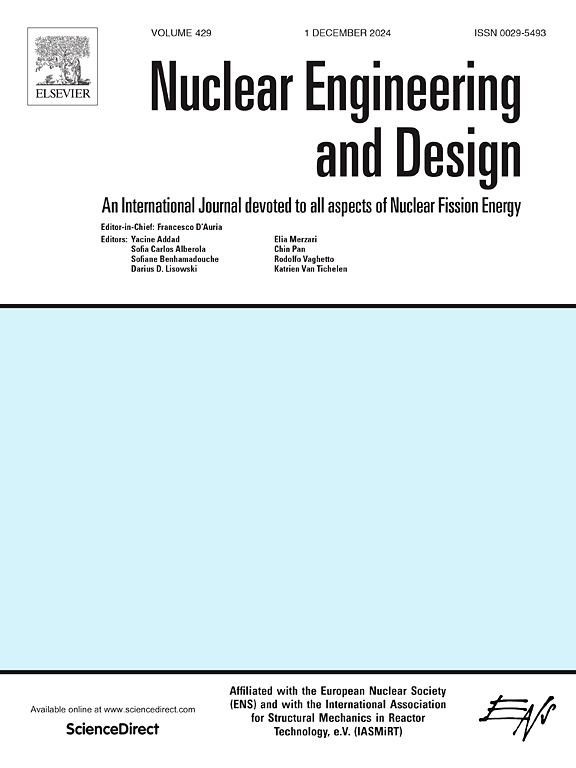Review of conceptual design and fundamental research related to the passive residual heat removal system in molten salt reactors
IF 1.9
3区 工程技术
Q1 NUCLEAR SCIENCE & TECHNOLOGY
引用次数: 0
Abstract
The molten salt reactor (MSR) is one of the six advanced reactor concepts declared by the Generation IV International Forum (GIF), which can be characterized by attractive attributes such as inherent safety, sustainable development, nuclear non-proliferation, natural resource protection, and economic efficiency. Passive residual heat removal systems for MSRs predominantly encompass Direct Reactor Auxiliary Cooling Systems (DRACS), Salt Discharge Tanks Residual Heat Removal Systems (DTRHRS), and Heat Pipes Residual Heat Removal Systems (HPRHRS). This study introduces an innovative Secondary Side Passive Residual Heat Removal System (SSHRS) for MSRs. The SSHRS employs the primary heat exchanger to dissipate the residual heat from the fuel salt in the primary loop, eliminating the necessity for an additional residual heat removal exchanger and enhancing economic efficiency. The SSHRS approach prevents direct heat transfer from the fuel salt to the environment, mitigates the risk of radioactive material leakage, and bolsters safety. Furthermore, this study also made a horizontal comparison of the advantages and disadvantages of DRACS, DTRHRS, and SSHRS in terms of safety and economy, and discussed the future research directions of passive residual heat removal from molten salt reactors.
熔盐堆被动余热排出系统的概念设计与基础研究综述
熔盐堆(MSR)是第四代国际论坛(GIF)宣布的六大先进反应堆概念之一,具有固有安全、可持续发展、核不扩散、自然资源保护和经济效率等吸引人的特性。msr的被动余热排出系统主要包括直接反应堆辅助冷却系统(DRACS)、盐排放罐余热排出系统(DTRHRS)和热管余热排出系统(HPRHRS)。本文介绍了一种新型的二次侧被动余热去除系统(SSHRS)。SSHRS采用一次热交换器来消散一次回路中燃料盐的余热,消除了额外的余热去除交换器的必要性,提高了经济效率。SSHRS方法可以防止热量从燃料盐直接传递到环境中,减轻放射性物质泄漏的风险,并提高安全性。此外,本研究还横向比较了DRACS、DTRHRS和SSHRS在安全性和经济性方面的优缺点,并探讨了熔盐堆被动余热去除的未来研究方向。
本文章由计算机程序翻译,如有差异,请以英文原文为准。
求助全文
约1分钟内获得全文
求助全文
来源期刊

Nuclear Engineering and Design
工程技术-核科学技术
CiteScore
3.40
自引率
11.80%
发文量
377
审稿时长
5 months
期刊介绍:
Nuclear Engineering and Design covers the wide range of disciplines involved in the engineering, design, safety and construction of nuclear fission reactors. The Editors welcome papers both on applied and innovative aspects and developments in nuclear science and technology.
Fundamentals of Reactor Design include:
• Thermal-Hydraulics and Core Physics
• Safety Analysis, Risk Assessment (PSA)
• Structural and Mechanical Engineering
• Materials Science
• Fuel Behavior and Design
• Structural Plant Design
• Engineering of Reactor Components
• Experiments
Aspects beyond fundamentals of Reactor Design covered:
• Accident Mitigation Measures
• Reactor Control Systems
• Licensing Issues
• Safeguard Engineering
• Economy of Plants
• Reprocessing / Waste Disposal
• Applications of Nuclear Energy
• Maintenance
• Decommissioning
Papers on new reactor ideas and developments (Generation IV reactors) such as inherently safe modular HTRs, High Performance LWRs/HWRs and LMFBs/GFR will be considered; Actinide Burners, Accelerator Driven Systems, Energy Amplifiers and other special designs of power and research reactors and their applications are also encouraged.
 求助内容:
求助内容: 应助结果提醒方式:
应助结果提醒方式:


